Scientific publications and books
Septentrion Environnement strongly believes in the importance of sharing knowledge. Committed to an Open Science approach, the majority of our works are published under a Creative Common BY 4.0 license: they can be downloaded, shared and adapted freely, provided that the original work is cited.
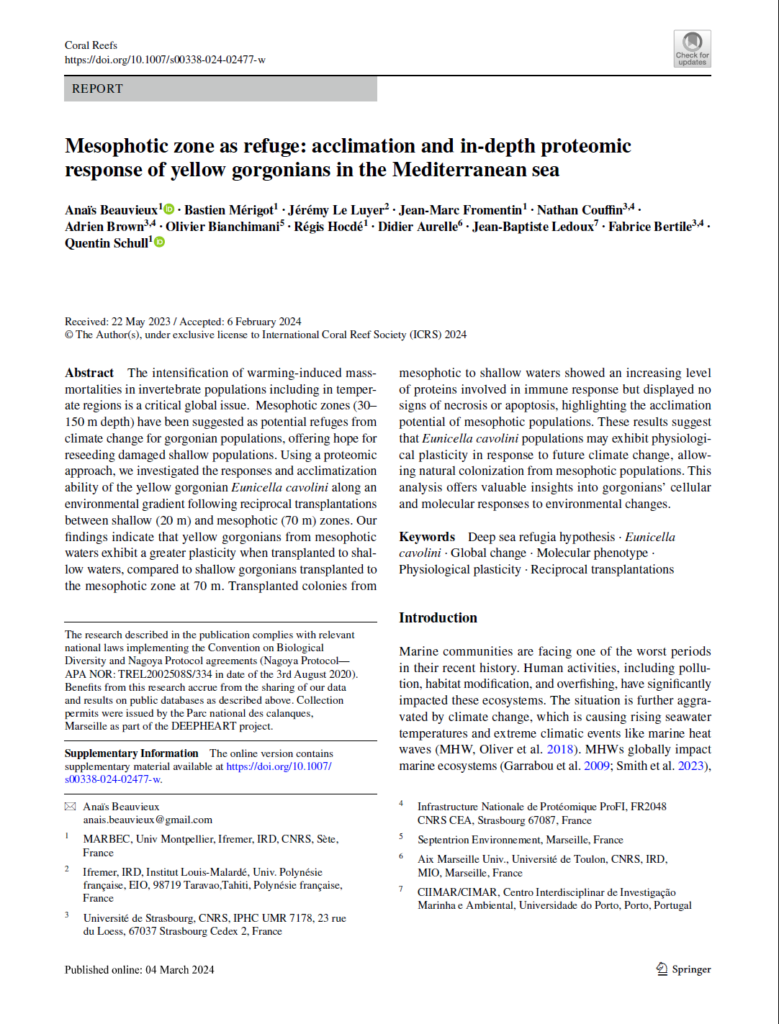
2024
Scientific publications and books
Mesophotic zone as refuge: acclimation and in-depth proteomic response of yellow gorgonians in the Mediterranean sea
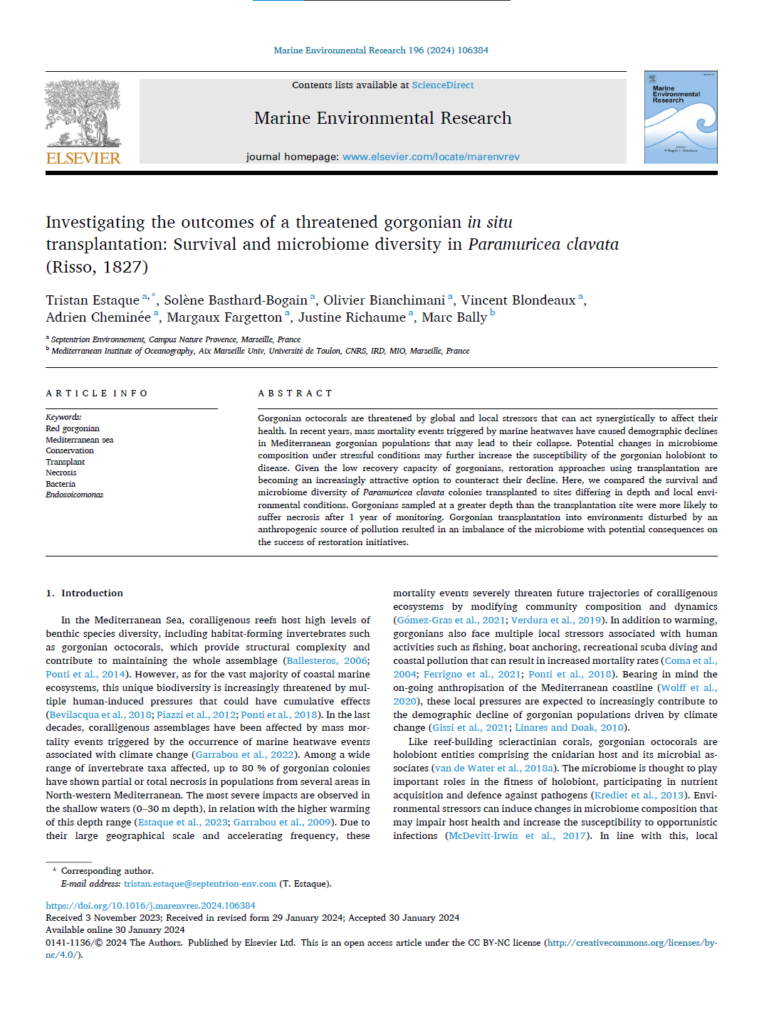
2024
Scientific publications and books
Investigating the outcomes of a threatened gorgonian in situ transplantation: Survival and microbiome diversity in Paramuricea clavata (Risso, 1827)
Estaque, T., Basthard-Bogain, S., Bianchimani, O., Blondeaux, V., Cheminée, A., Fargetton, M., Richaume, J., & Bally, M.
Abstract
Gorgonian octocorals are threatened by global and local stressors that can act synergistically to affect their health. In recent years, mass mortality events triggered by marine heatwaves have caused demographic declines in Mediterranean gorgonian populations that may lead to their collapse. Potential changes in microbiome composition under stressful conditions may further increase the susceptibility of the gorgonian holobiont to disease. Given the low recovery capacity of gorgonians, restoration approaches using transplantation are becoming an increasingly attractive option to counteract their decline. Here, we compared the survival and microbiome diversity of Paramuricea clavata colonies transplanted to sites differing in depth and local environmental conditions. Gorgonians sampled at a greater depth than the transplantation site were more likely to suffer necrosis after 1 year of monitoring. Gorgonian transplantation into environments disturbed by an anthropogenic source of pollution resulted in an imbalance of the microbiome with potential consequences on the success of restoration initiatives.
Keywords
Red gorgonian ;Mediterranean sea; Conservation; Transplant; Necrosis; Bacteria; Endozoicomonas
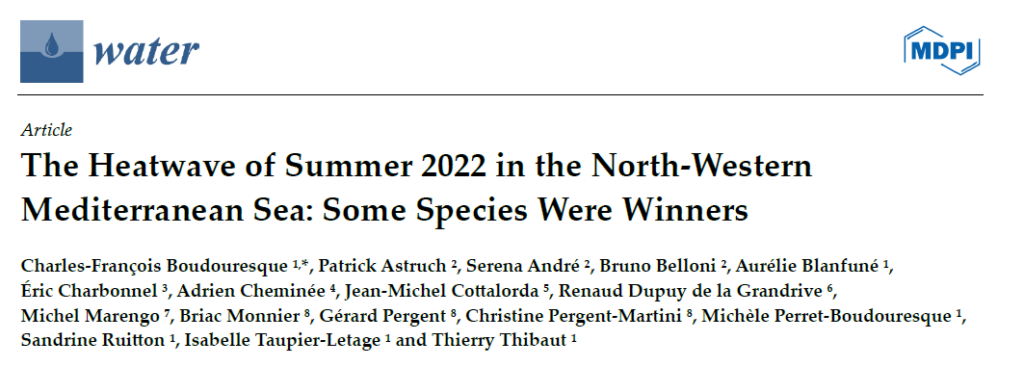
2024
Scientific publications and books
The Heatwave of Summer 2022 in the North-Western Mediterranean Sea: Some Species Were Winners
Charles-François Boudouresque, Patrick Astruch, Serena André, Bruno Belloni, Aurélie Blanfuné, Éric Charbonnel, Adrien Cheminée, Jean-Michel Cottalorda, Renaud Dupuy de la Grandrive, Michel Marengo, Briac Monnier, Gérard Pergent, Christine Pergent-Martini, Michèle Perret-Boudouresque , Sandrine Ruitton, Isabelle Taupier-Letage and Thierry Thibaut
Abstract :
The warming trend of the Mediterranean Sea is a long-term process. It has resulted in a northwards and westwards range expansion and abundance increase of thermophilic species, both native and non-indigenous, and in a shrinking of the range of cold-affinity species. Marine heatwaves (MHWs) are relatively short-term extreme episodes that are responsible for spectacular mortality events in some species and have been extensively reported in the literature. In contrast, the species that benefit from MHWs (the ‘winners’) have been much less studied. A record-breaking MHW occurred in 2022 in the north-western Mediterranean Sea. We focus on three ‘winner’ species, the thermophilic green macroalgae Penicillus capitatus and Microdictyon umbilicatum and the endemic seagrass Posidonia oceanica. Penicillus capitatus, which is mainly present in the area as an inconspicuous turf of entangled filaments (espera stage), produced the erect paintbrush-like stage where sexual reproduction takes place. Microdictyon umbilicatum, usually uncommon, bloomed to the point of clogging fishing nets. Finally, a mass flowering of P. oceanica occurred in late August–September, followed the following year (April–May 2023) by the extensive production and dissemination of fruits and seeds. Both processes, the long-term warming trend and one-off heatwaves, both ‘losers’ and ‘winners’, shape the change in structure and functioning of Mediterranean ecosystems.
flowering; marine heatwaves; Mediterranean; Microdictyon umbilicatum; Penicillus capitatus; Posidonia oceanica
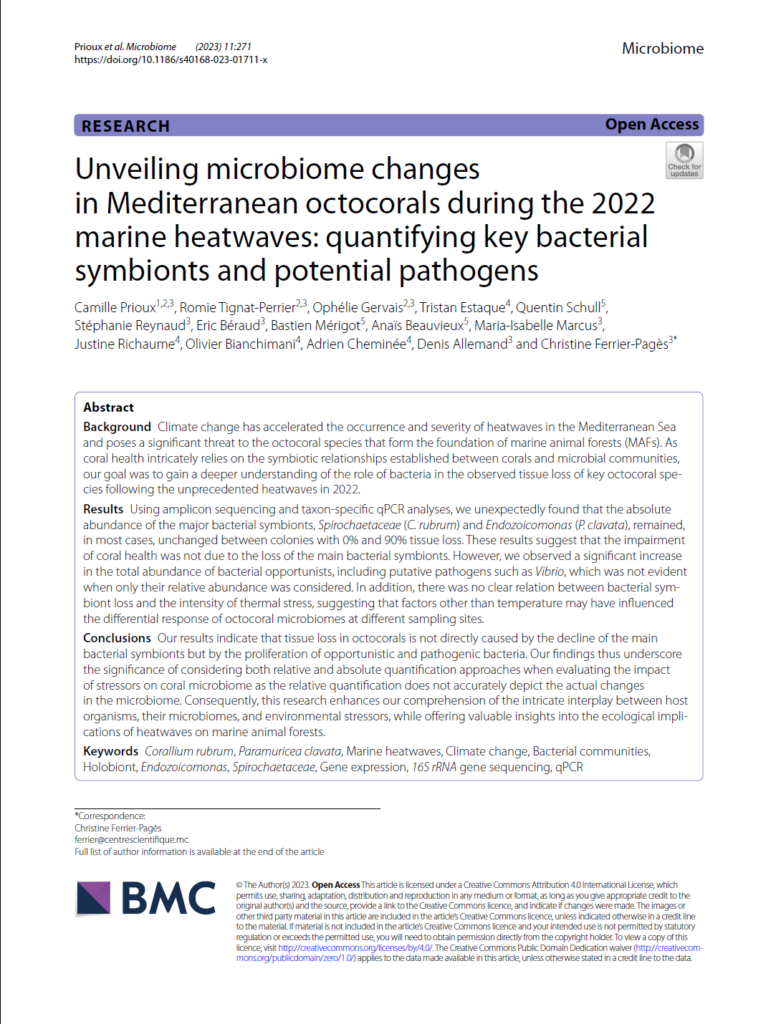
2023
Scientific publications and books
Unveiling microbiome changes in Mediterranean octocorals during the 2022 marine heatwaves: quantifying key bacterial symbionts and potential pathogens
Prioux C., Tignat-Perrier R., Gervais O., Estaque T., Schull Q., Reynaud S., Béraud E., Mérigot B., Beauvieux A., Marcus M.-I., Richaume J., Bianchimani O., Cheminée C., Allemand D., Ferrier-Pagès C.
Background
Climate change has accelerated the occurrence and severity of heatwaves in the Mediterranean Sea and poses a significant threat to the octocoral species that form the foundation of marine animal forests (MAFs). As coral health intricately relies on the symbiotic relationships established between corals and microbial communities, our goal was to gain a deeper understanding of the role of bacteria in the observed tissue loss of key octocoral species following the unprecedented heatwaves in 2022.
Results
Using amplicon sequencing and taxon-specific qPCR analyses, we unexpectedly found that the absolute abundance of the major bacterial symbionts, Spirochaetaceae (C. rubrum) and Endozoicomonas (P. clavata), remained, in most cases, unchanged between colonies with 0% and 90% tissue loss. These results suggest that the impairment of coral health was not due to the loss of the main bacterial symbionts. However, we observed a significant increase in the total abundance of bacterial opportunists, including putative pathogens such as Vibrio, which was not evident when only their relative abundance was considered. In addition, there was no clear relation between bacterial symbiont loss and the intensity of thermal stress, suggesting that factors other than temperature may have influenced the differential response of octocoral microbiomes at different sampling sites.
Conclusions
Our results indicate that tissue loss in octocorals is not directly caused by the decline of the main bacterial symbionts but by the proliferation of opportunistic and pathogenic bacteria. Our findings thus underscore the significance of considering both relative and absolute quantification approaches when evaluating the impact of stressors on coral microbiome as the relative quantification does not accurately depict the actual changes in the microbiome. Consequently, this research enhances our comprehension of the intricate interplay between host organisms, their microbiomes, and environmental stressors, while offering valuable insights into the ecological implications of heatwaves on marine animal forests.
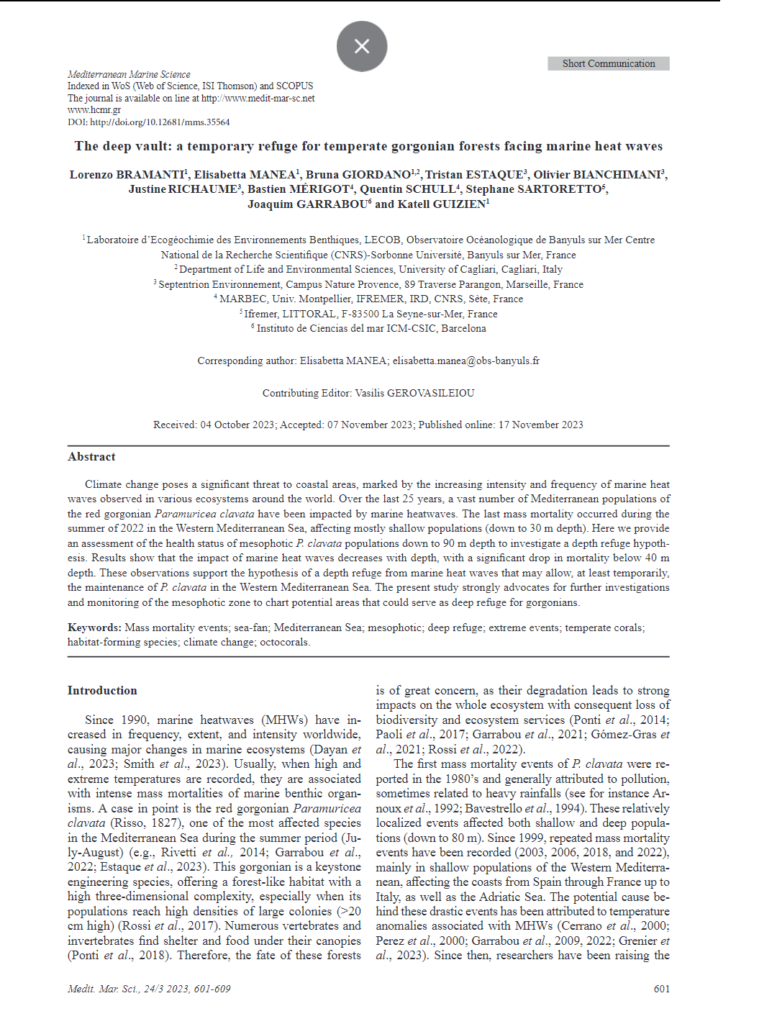
2023
Scientific publications and books
The deep vault: a temporary refuge for temperate gorgonian forests facing marine heat waves
Bramanti L., Manea E., Giordano B., Estaque T., Bianchimani O., Richaume J., Mérigot B., Schull Q., Sartoretto S., Garrabou J., Guizien K.
Climate change poses a significant threat to coastal areas, marked by the increasing intensity and frequency of marine heat waves observed in various ecosystems around the world. Over the last 25 years, a vast number of Mediterranean populations of the red gorgonian Paramuricea clavata have been impacted by marine heatwaves. The last mass mortality occurred during the summer of 2022 in the Western Mediterranean Sea, affecting mostly shallow populations (down to 30 m depth). Here we provide an assessment of the health status of mesophotic P. clavata populations down to 90 m depth to investigate a depth refuge hypoth-esis. Results show that the impact of marine heat waves decreases with depth, with a significant drop in mortality below 40 m depth. These observations support the hypothesis of a depth refuge from marine heat waves that may allow, at least temporarily, the maintenance of P. clavata in the Western Mediterranean Sea. The present study strongly advocates for further investigations and monitoring of the mesophotic zone to chart potential areas that could serve as deep refuge for gorgonians.
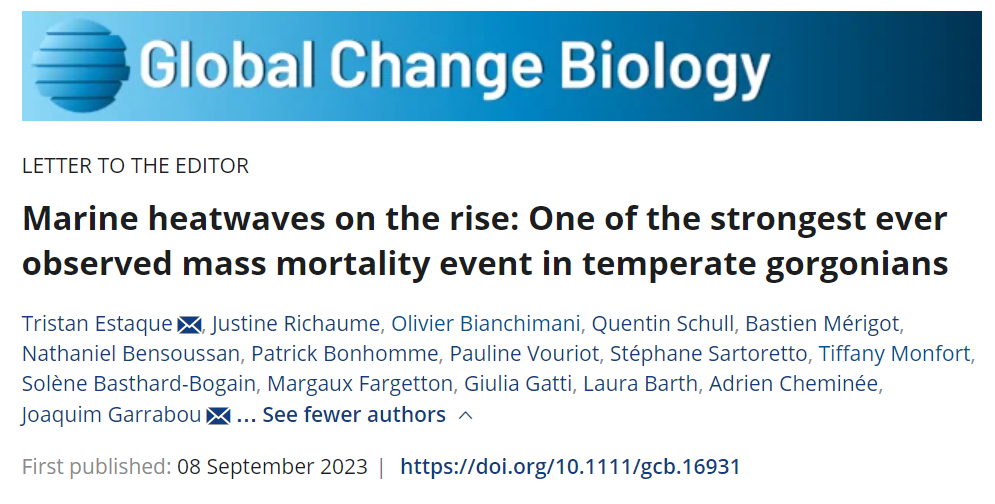
2023
Scientific publications and books
Marine heatwaves on the rise: One of the strongest ever observed mass mortality event in temperate gorgonians
Estaque T., Richaume J., Bianchimani O., Schull Q., Mérigot B., Bensoussan N., Bonhomme P., Vouriot P., Sartoretto S., Monfort T., Basthard-Bogain S., Fargetton M., Gatti G., Barth L., Cheminée A., Garrabou J.
Gorgonian population after the 2022 mass mortality event (MME) in the Calanques National Park. The year 2022 was marked by a historic gorgonian MME. This study describes the consequences for the red gorgonian (Paramuricea clavata) and red coral (Corallium rubrum) populations in the Calanques National Park (Marseille, France).
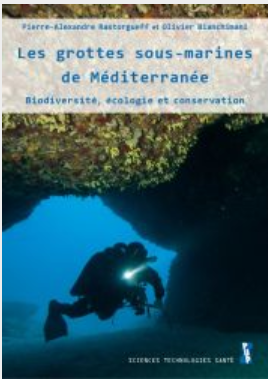
2023
Scientific publications and books
Les grottes sous-marines de Méditerranée
Rastorgueff P.-A., Bianchimani O.
The underwater caves of the Mediterranean Sea constitute a fascinating ecosystem because of many apparent paradoxes. This book proposes to discover the beauty and the magic of the underwater caves of the Mediterranean Sea thanks to a dive into the scientific knowledge available and made accessible to all the curious. It is also accompanied by numerous photographs taken in situ in order to transcribe the atmosphere of a cave dive.
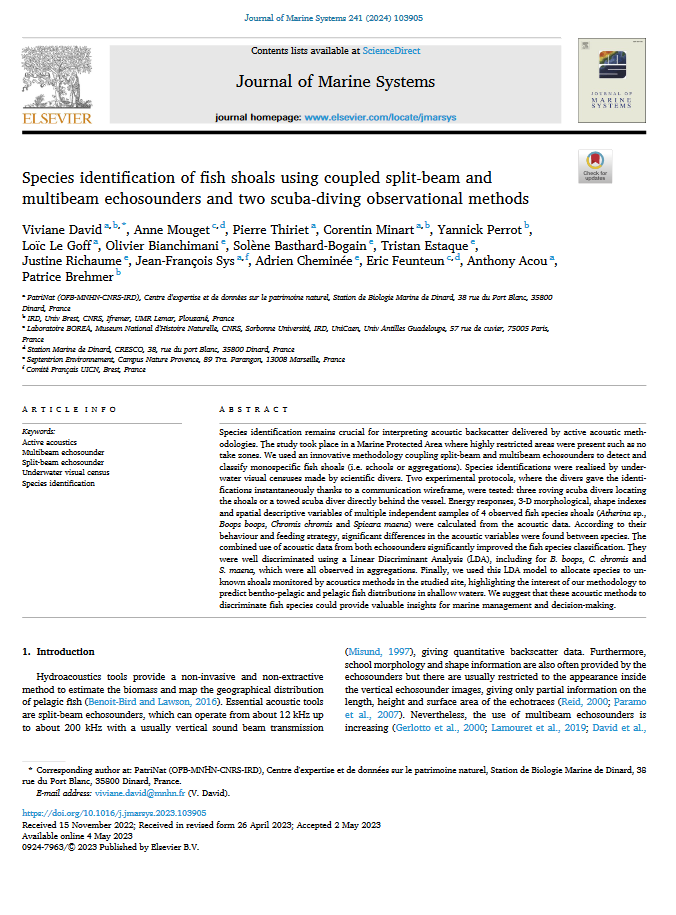
2023
Scientific publications and books
Species identification of fish shoals using coupled split-beam and multibeam echosounders and two scuba-diving observational methods
David V., Mouget A., Thiriet P., Minart C., Perrot Y., Le Goff L.,Bianchimani O., Basthard-Bogain S., Estaque T., Richaume J., Sys J.-F., Cheminée A., Feunteun E., Acou A., Brehmer, P.
Species identification remains crucial for interpreting acoustic backscatter delivered by active acoustic methodologies. The study took place in a Marine Protected Area where highly restricted areas were present such as no take zones. We used an innovative methodology coupling split-beam and multibeam echosounders to detect and classify monospecific fish shoals (i.e. schools or aggregations). Species identifications were realised by underwater visual censuses made by scientific divers. Two experimental protocols, where the divers gave the identifications instantaneously thanks to a communication wireframe, were tested: three roving scuba divers locating the shoals or a towed scuba diver directly behind the vessel. Energy responses, 3-D morphological, shape indexes and spatial descriptive variables of multiple independent samples of 4 observed fish species shoals (Atherina sp., Boops boops, Chromis chromis and Spicara maena) were calculated from the acoustic data. According to their behaviour and feeding strategy, significant differences in the acoustic variables were found between species. The combined use of acoustic data from both echosounders significantly improved the fish species classification. They were well discriminated using a Linear Discriminant Analysis (LDA), including for B. boops, C. chromis and S. maena, which were all observed in aggregations. Finally, we used this LDA model to allocate species to unknown shoals monitored by acoustics methods in the studied site, highlighting the interest of our methodology to predict bentho-pelagic and pelagic fish distributions in shallow waters. We suggest that these acoustic methods to discriminate fish species could provide valuable insights for marine management and decision-making.
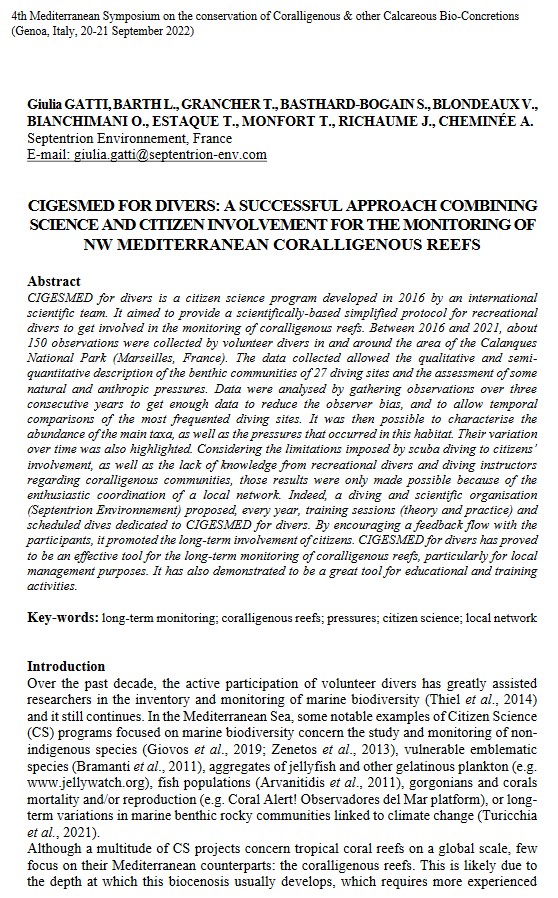
2022
Congresses and conferences
CIGESMED for divers: a successful approach combining science and citizen involvement for the monitoring of NW Mediterranean coralligenous reefs
Gatti G., Barth L., Grancher T., Bastard–Bogain S., Blondeaux V., Bianchimani O., Estaque T., Monfort T., Richaume J., Cheminée A.
CIGESMED for divers is a citizen science program developed in 2016 by an international scientific team. It aimed to provide a scientifically–based simplified protocol for recreational divers to get involved in the monitoring of coralligenous reefs. Between 2016 and 2021, about 150 observations were collected by volunteer divers in and around the area of the Calanques National Park (Marseilles, France). The data collected allowed the qualitative and semi–quantitative description of the benthic communities of 27 diving sites and the assessment of some natural and anthropic pressures. Data were analysed by gathering observations over three consecutive years to get enough data to reduce the observer bias, and to allow temporal comparisons of the most frequented diving sites. It was then possible to characterise the abundance of the main taxa, as well as the pressures that occurred in this habitat. Their variation over time was also highlighted. Considering the limitations imposed by scuba diving to citizens’ involvement, as well as the lack of knowledge from recreational divers and diving instructors regarding coralligenous communities, those results were only made possible because of the enthusiastic coordination of a local network. Indeed, a diving and scientific organisation (Septentrion Environnement) proposed, every year, training sessions (theory and practice) and scheduled dives dedicated to CIGESMED for divers. By encouraging a feedback flow with the participants, it promoted the long–term involvement of citizens. CIGESMED for divers has proved to be an effective tool for the long–term monitoring of coralligenous reefs, particularly for local management purposes. It has also demonstrated to be a great tool for educational and training activities.
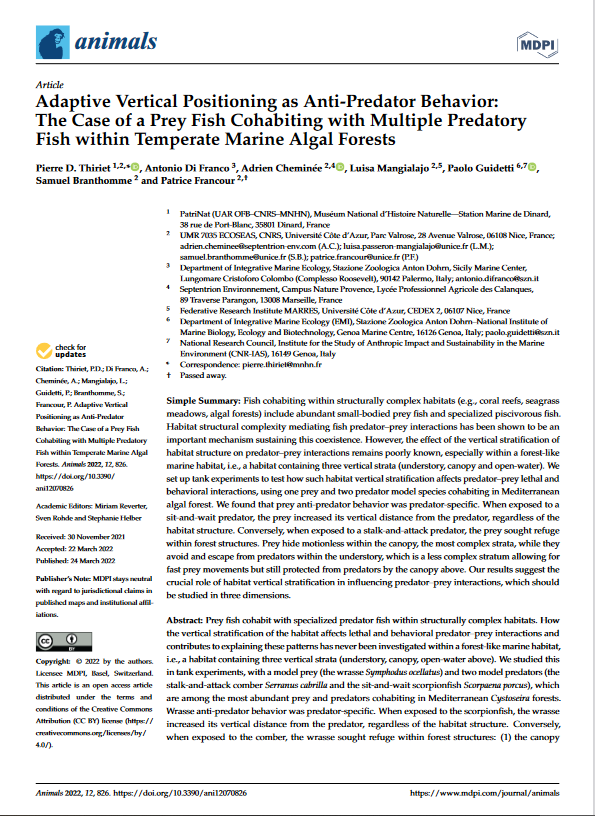
2022
Scientific publications and books
Adaptive Vertical Positioning as Anti-Predator Behavior: The Case of a Prey Fish Cohabiting with Multiple Predatory Fish within Temperate Marine Algal Forests
Fish cohabiting within structurally complex habitats (e.g., coral reefs, seagrass meadows, algal forests) include abundant small-bodied prey fish and specialized piscivorous fish. Habitat structural complexity mediating fish predator–prey interactions has been shown to be an important mechanism sustaining this coexistence. However, the effect of the vertical stratification of habitat structure on predator–prey interactions remains poorly known, especially within a forest-like marine habitat, i.e., a habitat containing three vertical strata (understory, canopy and open-water). We set up tank experiments to test how such habitat vertical stratification affects predator–prey lethal and behavioral interactions, using one prey and two predator model species cohabiting in Mediterranean algal forest. We found that prey anti-predator behavior was predator-specific. When exposed to a sit-and-wait predator, the prey increased its vertical distance from the predator, regardless of the habitat structure. Conversely, when exposed to a stalk-and-attack predator, the prey sought refuge within forest structures. Prey hide motionless within the canopy, the most complex strata, while they avoid and escape from predators within the understory, which is a less complex stratum allowing for fast prey movements but still protected from predators by the canopy above. Our results suggest the crucial role of habitat vertical stratification in influencing predator–prey interactions, which should be studied in three dimensions.
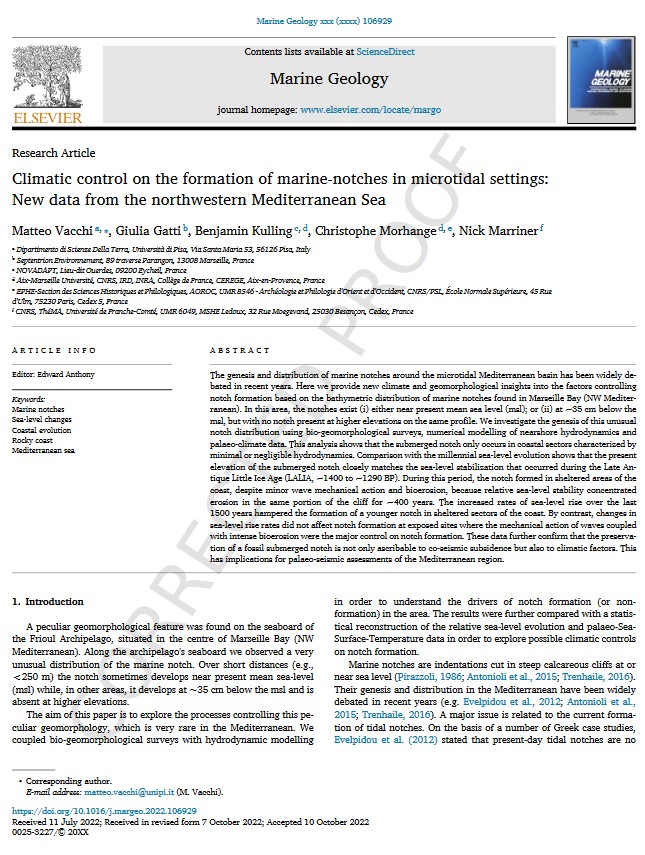
2022
Scientific publications and books
Climatic control on the formation of marine-notches in microtidal settings: new data from the northwestern Mediterranean Sea
Vacchi M., Gatti G., Kulling B., Morhange C., Marriner N.
The genesis and distribution of marine notches around the microtidal Mediterranean basin has been widely debated in recent years. Here we provide new climate and geomorphological insights into the factors controlling notch formation based on the bathymetric distribution of marine notches found in Marseille Bay (NW Mediterranean). In this area, the notches exist (i) either near present Mean Sea Level (MSL); or (ii) at ∼35 cm below the MSL, but with no notch present at higher elevations on the same profile. We investigate the genesis of this unusual notch distribution using bio-geomorphological surveys, numerical modelling of nearshore hydrodynamics and palaeo-climate data. This analysis shows that the submerged notch only occurs in coastal sectors characterized by minimal or negligible hydrodynamics. Comparison with the millennial sea-level evolution shows that the present elevation of the submerged notch closely matches the sea-level stabilization that occurred during the Late Antique Little Ice Age (LALIA, ∼1400 to ∼1290 BP). During this period, the notch formed in sheltered areas of the coast, despite minor wave mechanical action and bioerosion, because relative sea-level stability concentrated erosion in the same portion of the cliff for ∼400 years. The increased rates of sea-level rise over the last 1500 years hampered the formation of a younger notch in sheltered sectors of the coast. By contrast, changes in sea-level rise rates did not affect notch formation at exposed sites where the mechanical action of waves coupled with intense bioerosion were the major control on notch formation. These data further confirm that the preservation of a fossil submerged notch is not only ascribable to co-seismic subsidence but also to climatic factors. This has implications for palaeo-seismic assessments of the Mediterranean region.
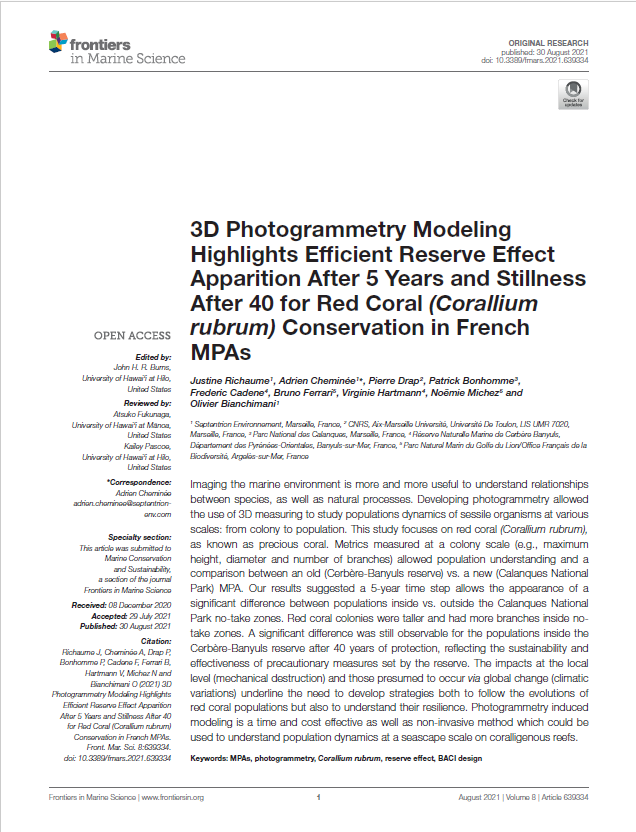
2021
Scientific publications and books
3D photogrammetry modeling highlights efficient reserve effect apparition after 5 years and stillness after 40 for red coral (Corallium rubrum) conservation in French MPAs
Richaume J., Cheminée A., Drap P., Bonhomme P., Cadene F., Ferrari B., Hartmann V., Michez N., Bianchimani O.
Imaging the marine environment is more and more useful to understand relationships between species, as well as natural processes. Developing photogrammetry allowed the use of 3D measuring to study populations dynamics of sessile organisms at various scales: from colony to population. This study focuses on red coral (Corallium rubrum), as known as precious coral. Metrics measured at a colony scale (e.g., maximum height, diameter and number of branches) allowed population understanding and a comparison between an old (Cerbère-Banyuls reserve) vs. a new (Calanques National Park) MPA.
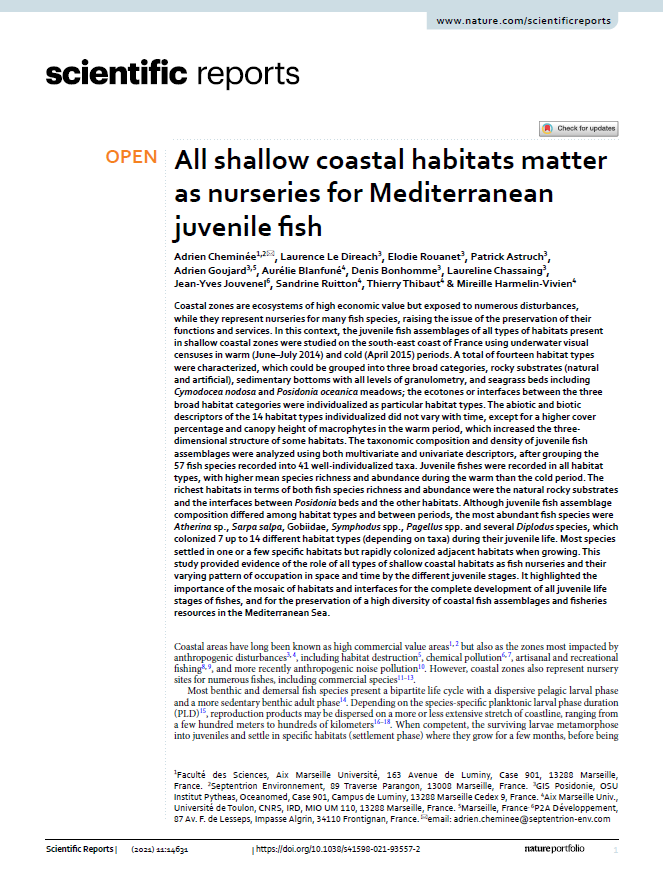
2021
Scientific publications and books
All shallow coastal habitats matter as nurseries for Mediterranean juvenile fish
Cheminée A., Le Direach L., Rouanet E., Astruch P., Goujard A., Blanfuné A., Bonhomme D., Chassaing L., Jouvenel J.-Y., Ruitton S., Thibaut T., Harmelin‑Vivien M.
Coastal zones are ecosystems of high economic value but exposed to numerous disturbances, while they represent nurseries for many fish species, raising the issue of the preservation of their functions and services. In this context, the juvenile fish assemblages of all types of habitats present in shallow coastal zones were studied on the south-east coast of France using underwater visual censuses in warm (June–July 2014) and cold (April 2015) periods. A total of fourteen habitat types were characterized, which could be grouped into three broad categories, rocky substrates (natural and artificial), sedimentary bottoms with all levels of granulometry, and seagrass beds including Cymodocea nodosa and Posidonia oceanica meadows; the ecotones or interfaces between the three broad habitat categories were individualized as particular habitat types.
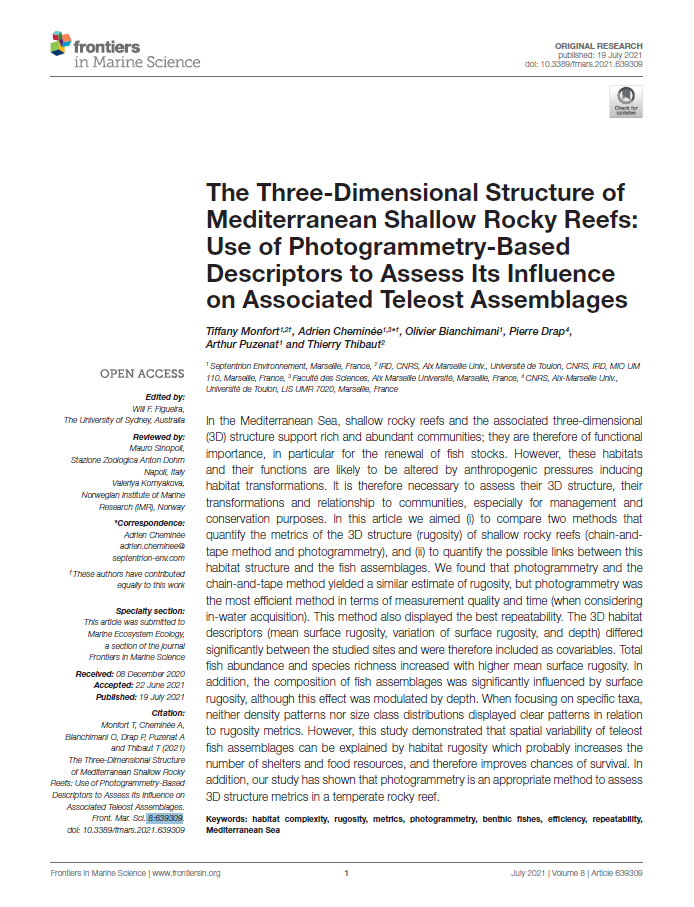
2021
Scientific publications and books
The three-dimensional structure of Mediterranean shallow rocky reefs: use of photogrammetry-based descriptors to assess its influence on associated teleost assemblages
Monfort T., Cheminée A., Bianchimani O., Drap P., Puzenat A., Thibaut T.
In the Mediterranean Sea, shallow rocky reefs and the associated three-dimensional (3D) structure support rich and abundant communities; they are therefore of functional importance, in particular for the renewal of fish stocks. However, these habitats and their functions are likely to be altered by anthropogenic pressures inducing habitat transformations. It is therefore necessary to assess their 3D structure, their transformations and relationship to communities, especially for management and conservation purposes. In this article we aimed (i) to compare two methods that quantify the metrics of the 3D structure (rugosity) of shallow rocky reefs (chain-and-tape method and photogrammetry), and (ii) to quantify the possible links between this habitat structure and the fish assemblages.
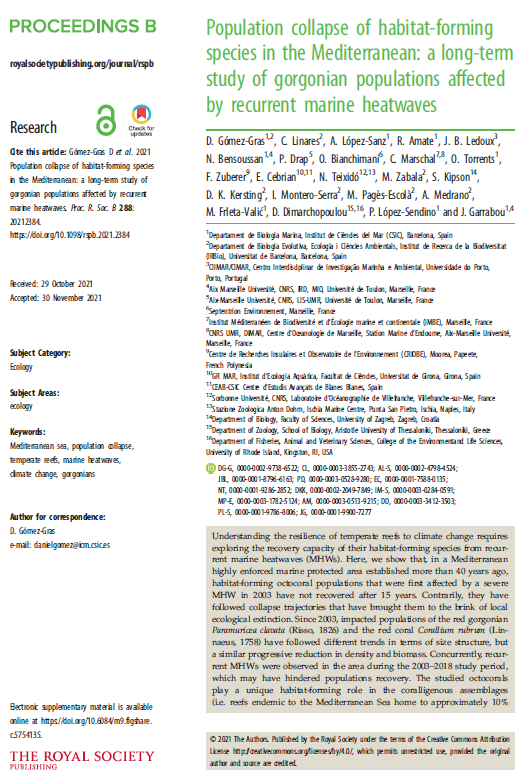
2021
Scientific publications and books
Population collapse of habitat-forming species in the Mediterranean: a long-term study of gorgonian populations affected by recurrent marine heatwaves
Gómez-Gras D., Linares C., López-Sanz A., Amate R., Ledoux J. B., Bensoussan N., Drap P., Bianchimani O., Marschal C., Torrents O., Zuberer F., Cebrian E., Teixidó N., Zabala M., Kipson S., Kersting D. K., Montero-Serra I., Pagès-Escolà M., Medrano A., Frleta-Valić M., Dimarchopoulou D., López-Sendino P., Garrabou J.
Understanding the resilience of temperate reefs to climate change requires exploring the recovery capacity of their habitat-forming species from recurrent marine heatwaves (MHWs). Here, we show that, in a Mediterranean highly enforced marine protected area established more than 40 years ago, habitat-forming octocoral populations that were affected by a severe MHW in 2003 have not recovered after 15 years. Contrarily, they have followed collapse trajectories that have brought them to the brink of local extinction. Since 2003, impacted populations of the red gorgonian Paramuricea clavata and the red coral Corallium rubrum have followed different trends in terms of size structure, but a similar progressive reduction in density and biomass. Concurrently, recurrent MHWs were observed in the area during 2003–2018, which may have hindered populations recovery. The studied octocorals play a unique habitat-forming role in the coralligenous assemblages . Therefore, our results underpin the great risk that recurrent MHWs pose for the long-term integrity and functioning of these emblematic temperate reefs.
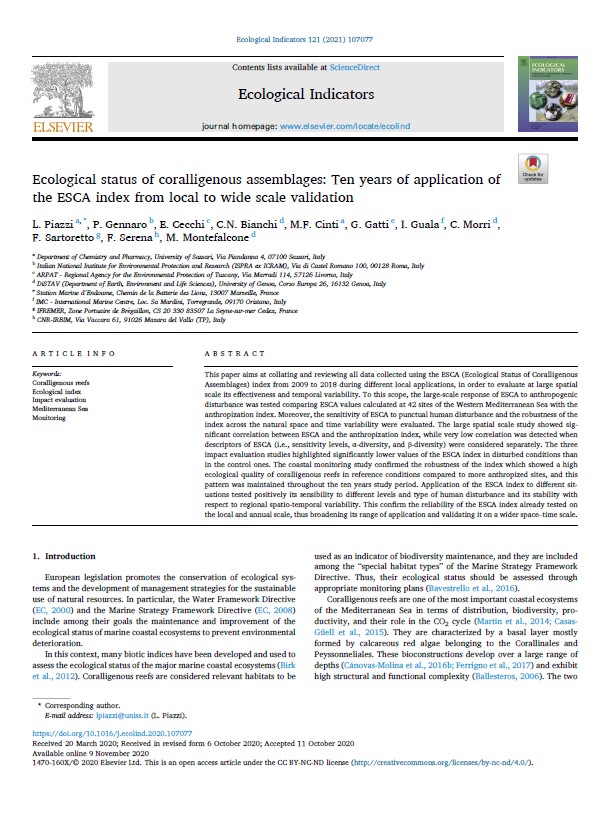
2021
Scientific publications and books
Ecological status of coralligenous assemblages: ten years of application of the ESCA index from local to wide scale validation
Piazzi L., Gennaro P., Cecchi E., Bianchi C.N., Cinti M.F., Gatti G., Guala I., Morri C., Sartoretto S., Serena F., Montefalcone M.
This paper aims at collating and reviewing all data collected using the ESCA (Ecological Status of Coralligenous Assemblages) index from 2009 to 2018 during different local applications, in order to evaluate at large spatial scale its effectiveness and temporal variability. To this scope, the large-scale response of ESCA to anthropogenic disturbance was tested comparing ESCA values calculated at 42 sites of the Western Mediterranean Sea with the anthropization index. Moreover, the sensitivity of ESCA to punctual human disturbance and the robustness of the index across the natural space and time variability were evaluated. The large spatial scale study showed significant correlation between ESCA and the anthropization index, while very low correlation was detected when descriptors of ESCA (i.e., sensitivity levels, α-diversity, and β-diversity) were considered separately. The three impact evaluation studies highlighted significantly lower values of the ESCA index in disturbed conditions than in the control ones. The coastal monitoring study confirmed the robustness of the index which showed a high ecological quality of coralligenous reefs in reference conditions compared to more anthropized sites, and this pattern was maintained throughout the ten years study period. Application of the ESCA index to different situations tested positively its sensibility to different levels and type of human disturbance and its stability with respect to regional spatio-temporal variability. This confirm the reliability of the ESCA index already tested on the local and annual scale, thus broadening its range of application and validating it on a wider space–time scale.
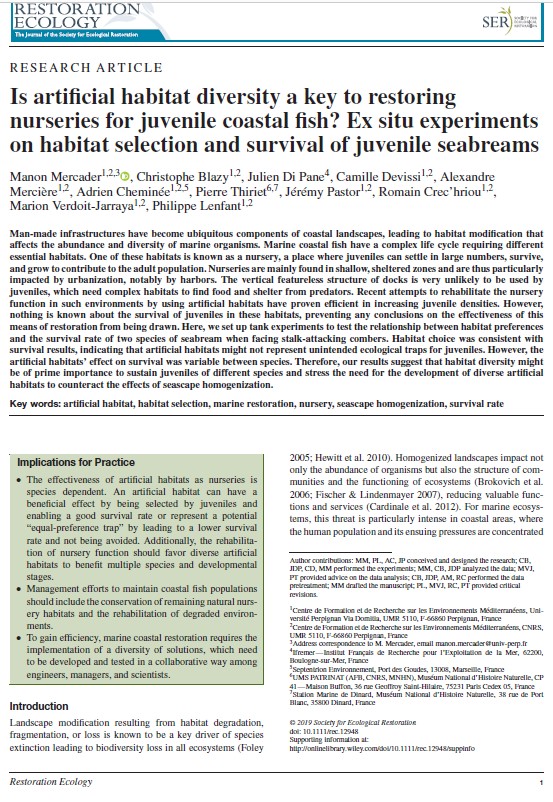
2019
Scientific publications and books
Is artificial habitat diversity a key to restoring nurseries for juvenile coastal fish? Ex situ experiments on habitat selection and survival of juvenile seabreams
Mercader M., Blazy C., Pane J.D., Devissi C., Mercière A., Cheminée A., Thiriet P., Pastor J., Crec’hriou R., Verdoit‐Jarraya M., Lenfant P.
Man-made infrastructures have become ubiquitous components of coastal landscapes, leading to habitat modification that affects the abundance and diversity of marine organisms. Marine coastal fish have a complex life cycle requiring different essential habitats. One of these habitats is known as a nursery, a place where juveniles can settle in large numbers, survive, and grow to contribute to the adult population. Nurseries aremainly found in shallow, sheltered zones and are thus particularly impacted by urbanization, notably by harbors. The vertical featureless structure of docks is very unlikely to be used by juveniles, which need complex habitats to find food and shelter from predators. Recent attempts to rehabilitate the nursery function in such environments by using artificial habitats have proven efficient in increasing juvenile densities. However, nothing is known about the survival of juveniles in these habitats, preventing any conclusions on the effectiveness of this means of restoration from being drawn. Here, we set up tank experiments to test the relationship between habitat preferences and the survival rate of two species of seabream when facing stalk-attacking combers. Habitat choice was consistent with survival results, indicating that artificial habitats might not represent unintended ecological traps for juveniles. However, the artificial habitats’ effect on survival was variable between species. Therefore, our results suggest that habitat diversity might be of prime importance to sustain juveniles of different species and stress the need for the development of diverse artificial habitats to counteract the effects of seascape homogenization.
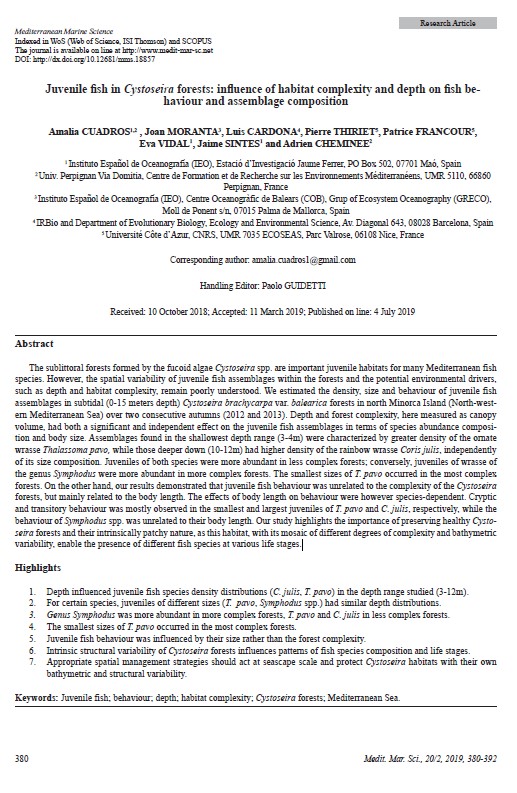
2019
Scientific publications and books
Juvenile fish in Cystoseira forests: influence of habitat complexity and depth on fish behaviour and assemblage composition
Cuadros A., Moranta J., Cardona L., Thiriet P., Francour P., Vidal E., Sintes J., Cheminee A.
The sublittoral forests formed by the fucoid algae Cystoseira spp. are important juvenile habitats for many Mediterranean fish species. However, the spatial variability of juvenile fish assemblages within the forests and the potential environmental drivers, such as depth and habitat complexity, remain poorly understood. We estimated the density, size and behaviour of juvenile fish
assemblages in subtidal (0-15 meters depth) Cystoseira brachycarpa var. balearica forests in north Minorca Island (North-western Mediterranean Sea) over two consecutive autumns (2012 and 2013). Depth and forest complexity, here measured as canopy volume, had both a significant and independent effect on the juvenile fish assemblages in terms of species abundance composition
and body size. Assemblages found in the shallowest depth range (3-4m) were characterized by greater density of the ornate wrasse Thalassoma pavo, while those deeper down (10-12m) had higher density of the rainbow wrasse Coris julis, independently of its size composition. Juveniles of both species were more abundant in less complex forests; conversely, juveniles of wrasse of
the genus Symphodus were more abundant in more complex forests. The smallest sizes of T. pavo occurred in the most complex forests. On the other hand, our results demonstrated that juvenile fish behaviour was unrelated to the complexity of the Cystoseira forests, but mainly related to the body length. The effects of body length on behaviour were however species-dependent. Cryptic
and transitory behaviour was mostly observed in the smallest and largest juveniles of T. pavo and C. julis, respectively, while the behaviour of Symphodus spp. was unrelated to their body length. Our study highlights the importance of preserving healthy Cystoseira forests and their intrinsically patchy nature, as this habitat, with its mosaic of different degrees of complexity and bathymetric variability, enable the presence of different fish species at various life stages.
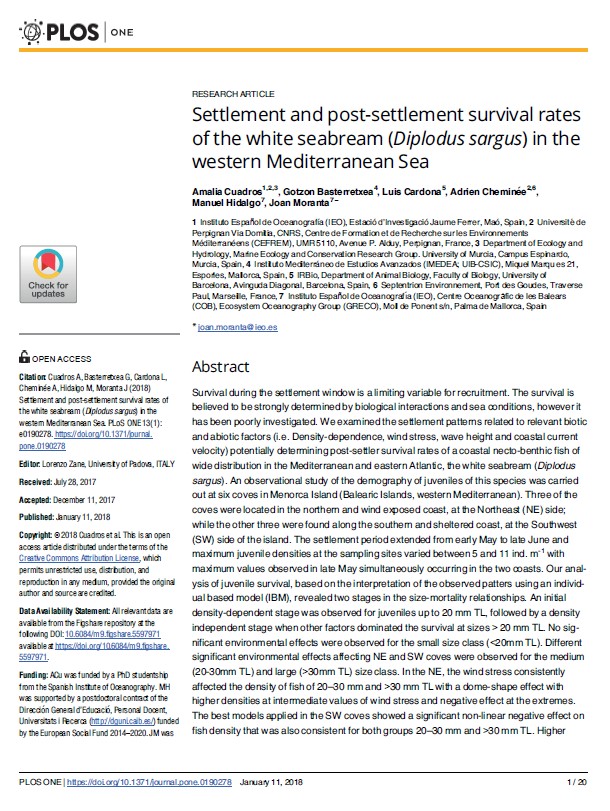
2018
Scientific publications and books
Settlement and post-settlement survival rates of the white seabream (Diplodus sargus) in the western Mediterranean Sea
Cuadros A., Basterretxea G., Cardona L., Cheminée A., Hidalgo M., Moranta J.
Survival during the settlement window is a limiting variable for recruitment. The survival is believed to be strongly determined by biological interactions and sea conditions, however it has been poorly investigated. We examined the settlement patterns related to relevant biotic and abiotic factors (i.e. Density-dependence, wind stress, wave height and coastal current velocity) potentially determining post-settler survival rates of a coastal necto-benthic fish of wide distribution in the Mediterranean and eastern Atlantic, the white seabream (Diplodus sargus). An observational study of the demography of juveniles of this species was carried out at six coves in Menorca Island (Balearic Islands, western Mediterranean). Three of the coves were located in the northern and wind exposed coast, at the Northeast (NE) side; while the other three were found along the southern and sheltered coast, at the Southwest (SW) side of the island. The settlement period extended from early May to late June and maximum juvenile densities at the sampling sites varied between 5 and 11 ind. m-1 with maximum values observed in late May simultaneously occurring in the two coasts. Our analysis of juvenile survival, based on the interpretation of the observed patters using an individual based model (IBM), revealed two stages in the size-mortality relationships. An initial density-dependent stage was observed for juveniles up to 20 mm TL, followed by a density independent stage when other factors dominated the survival at sizes > 20 mm TL. No significant
environmental effects were observed for the small size class (<20mm TL). Different significant environmental effects affecting NE and SW coves were observed for the medium (20-30mm TL) and large (>30mm TL) size class. In the NE, the wind stress consistently affected the density of fish of 20±30 mm and >30 mm TL with a dome-shape effect with higher densities at intermediate values of wind stress and negative effect at the extremes. The best models applied in the SW coves showed a significant non-linear negative effect on fish density that was also consistent for both groups 20±30 mm and >30 mm TL. Higher densities were observed at low values of wave height in the two groups. Because of these variations, the number of juveniles present at the end of the period was unrelated to their initial density and average survival varied among locations. In consequence, recruitment was (1) primarily limited by denso-dependient procedures at settlement stage, and (2) by sea conditions at post-settlement, where extreme wave conditions depleted juveniles. Accordingly, regional hydrodynamic conditions during the settlement season produced significant impacts on the juvenile densities depending on their size and with contrasted effects in respectto cove orientation. The similar strength in larval supply between coves, in addition
to the similar mean phenology for settlers in the north and south of the Island, suggests that all fish may come from the same parental reproductive pool. These factors should be taken into account when assessing relationships between settlers, recruits and adults of white seabream.
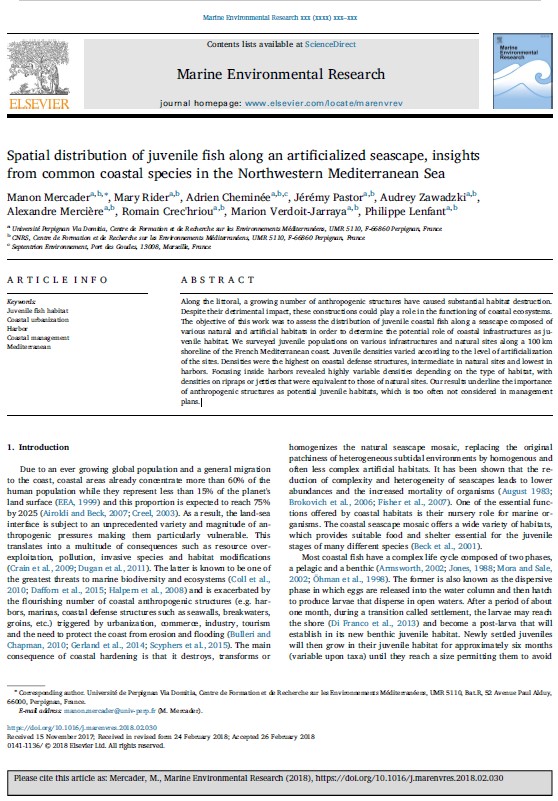
2018
Scientific publications and books
Spatial distribution of juvenile fish along an artificialized seascape, insights from common coastal species in the Northwestern Mediterranean Sea
Mercader M., Rider M., Cheminée A., Pastor J., Zawadzki A., Mercière A., Crec’hriou R., Verdoit-Jarraya M., Lenfant P.
Along the littoral, a growing number of anthropogenic structures have caused substantial habitat destruction. Despite their detrimental impact, these constructions could play a role in the functioning of coastal ecosystems. The objective of this work was to assess the distribution of juvenile coastal fish along a seascape composed of various natural and artificial habitats in order to determine the potential role of coastal infrastructures as juvenile habitat. We surveyed juvenile populations on various infrastructures and natural sites along a 100 km shoreline of the French Mediterranean coast. Juvenile densities varied according to the level of artificialization of the sites. Densities were the highest on coastal defense structures, intermediate in natural sites and lowest in harbors. Focusing inside harbors revealed highly variable densities depending on the type of habitat, with densities on ripraps or jetties that were equivalent to those of natural sites. Our results underline the importance of anthropogenic structures as potential juvenile habitats, which is too often not considered in management plans.
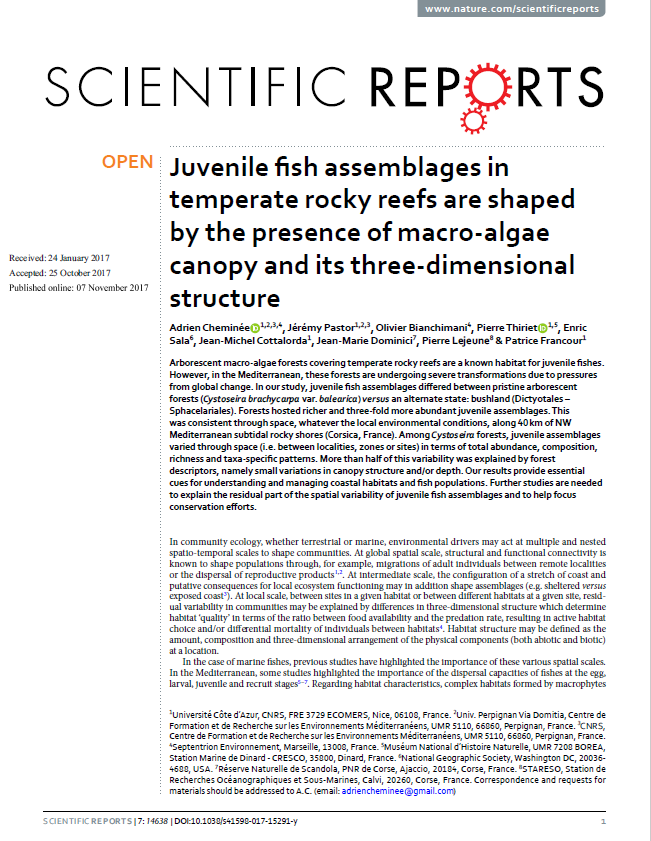
2017
Scientific publications and books
Juvenile fish assemblages in temperate rocky reefs are shaped by the presence of macro-algae canopy and its three-dimensional structure.
Cheminée A., Pastor J., Bianchimani O., Thiriet P., Sala E., Cottalorda J.-M., Dominici J.-M., Lejeune P., Francour P.
Arborescent macro-algae forests covering temperate rocky reefs are a known habitat for juvenile fishes. However, in the Mediterranean, these forests are undergoing severe transformations due to pressures from global change. In our study, juvenile fish assemblages differed between pristine arborescent forests (Cystoseira brachycarpa var. balearica) versus an alternate state: bushland (Dictyotales – Sphacelariales). Forests hosted richer and three-fold more abundant juvenile assemblages. This was consistent through space, whatever the local environmental conditions, along 40 km of NW Mediterranean subtidal rocky shores (Corsica, France).
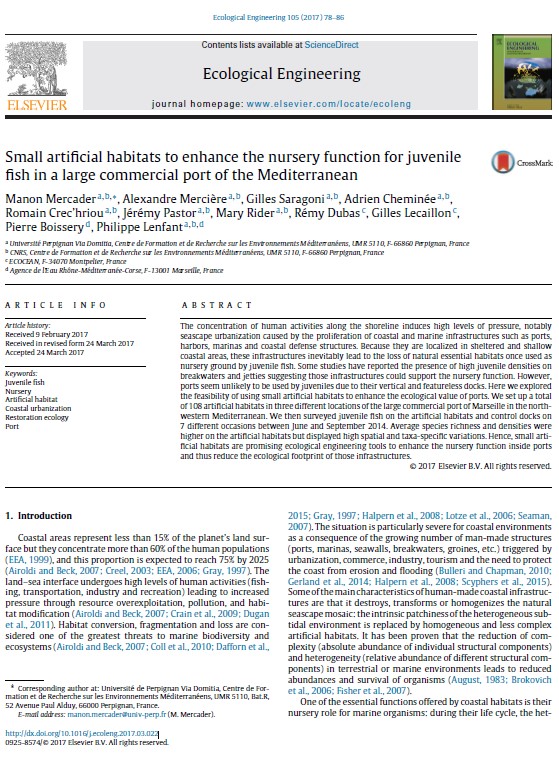
2017
Scientific publications and books
Small artificial habitats to enhance the nursery function for juvenile fish in a large commercial port of the Mediterranean
Mercader M., Mercière A., Saragoni G., Cheminée A., Crec’hriou R., Pastor J., Rider M., DUbas R., Lecaillon G., Boissery P., Lenfant, P.
The concentration of human activities along the shoreline induces high levels of pressure, notablyseascape urbanization caused by the proliferation of coastal and marine infrastructures such as ports,harbors, marinas and coastal defense structures. Because they are localized in sheltered and shallowcoastal areas, these infrastructures inevitably lead to the loss of natural essential habitats once used asnursery ground by juvenile fish. Some studies have reported the presence of high juvenile densities onbreakwaters and jetties suggesting those infrastructures could support the nursery function. However,ports seem unlikely to be used by juveniles due to their vertical and featureless docks. Here we exploredthe feasibility of using small artificial habitats to enhance the ecological value of ports. We set up a totalof 108 artificial habitats in three different locations of the large commercial port of Marseille in the north-western Mediterranean. We then surveyed juvenile fish on the artificial habitats and control docks on7 different occasions between June and September 2014. Average species richness and densities werehigher on the artificial habitats but displayed high spatial and taxa-specific variations. Hence, small arti-ficial habitats are promising ecological engineering tools to enhance the nursery function inside portsand thus reduce the ecological footprint of those infrastructures.
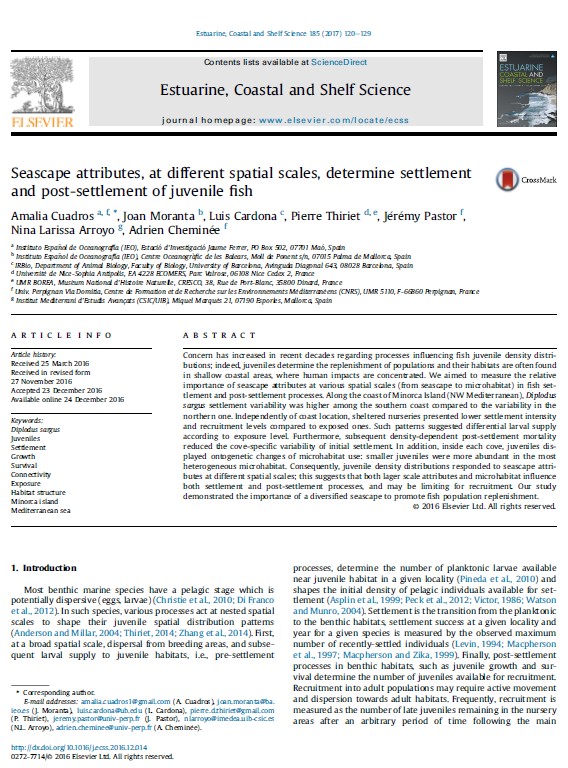
2017
Scientific publications and books
Seascape attributes, at different spatial scales, determine settlement and post-settlement of juvenile fish
Cuadros A., Moranta J., Cardona L., Thiriet P., Pastor J., Arroyo N.L., Cheminée A.
Concern has increased in recent decades regarding processes influencing fish juvenile density distributions; indeed, juveniles determine the replenishment of populations and their habitats are often found in shallow coastal areas, where human impacts are concentrated. We aimed to measure the relative importance of seascape attributes at various spatial scales (from seascape to microhabitat) in fish settlement and post-settlement processes. Along the coast of Minorca Island (NW Mediterranean), Diplodus sargus settlement variability was higher among the southern coast compared to the variability in the northern one. Independently of coast location, sheltered nurseries presented lower settlement intensity and recruitment levels compared to exposed ones. Such patterns suggested differential larval supply according to exposure level. Furthermore, subsequent density-dependent post-settlement mortality reduced the cove-specific variability of initial settlement. In addition, inside each cove, juveniles displayed ontogenetic changes of microhabitat use: smaller juveniles were more abundant in the most heterogeneous microhabitat. Consequently, juvenile density distributions responded to seascape attributes at different spatial scales; this suggests that both lager scale attributes and microhabitat influence both settlement and post-settlement processes, and may be limiting for recruitment. Our study demonstrated the importance of a diversified seascape to promote fish population replenishment.
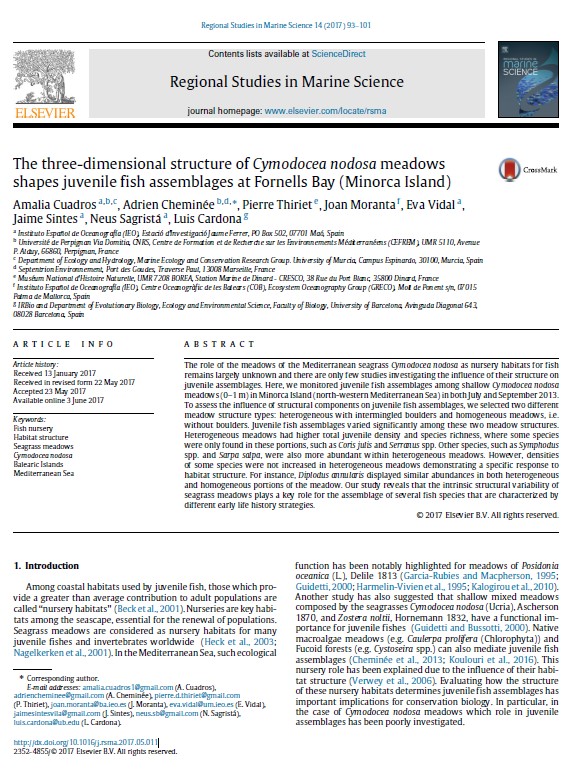
2017
Scientific publications and books
The three-dimensional structure of Cymodocea nodosa meadows shapes juvenile fish assemblages (Fornells Bay, Minorca Island)
Cuadros A., Cheminée A., Thiriet P.D., Moranta J., Vidal E., Sintes Vila J., Sagrista N., Cardona L.
The role of the meadows of the Mediterranean seagrass Cymodocea nodosa as nursery habitats for fish remains largely unknown and there are only few studies investigating the influence of their structure on juvenile assemblages. Here, we monitored juvenile fish assemblages among shallow Cymodocea nodosa meadows (0–1 m) in Minorca Island (north-western Mediterranean Sea) in both July and September 2013. To assess the influence of structural components on juvenile fish assemblages, we selected two different meadow structure types: heterogeneous with intermingled boulders and homogeneous meadows, i.e. without boulders. Juvenile fish assemblages varied significantly among these two meadow structures. Heterogeneous meadows had higher total juvenile density and species richness, where some species were only found in these portions, such as Coris julis and Serranus spp. Other species, such as Symphodus spp. and Sarpa salpa, were also more abundant within heterogeneous meadows. However, densities of some species were not increased in heterogeneous meadows demonstrating a specific response to habitat structure. For instance, Diplodus annularis displayed similar abundances in both heterogeneous and homogeneous portions of the meadow. Our study reveals that the intrinsic structural variability of seagrass meadows plays a key role for the assemblage of several fish species that are characterized by different early life history strategies.
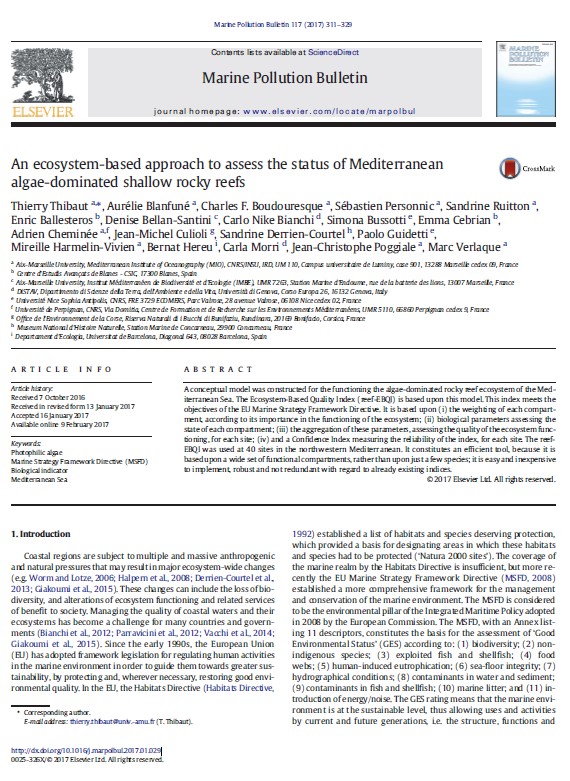
2017
Scientific publications and books
An ecosystem-based approach to assess the status of Mediterranean algae-dominated shallow rocky reefs
Thibaut T., Blanfuné A., Boudouresque C.F., Personnic S., Ruitton S., Ballesteros E., Bellan-Santini D., Bianchi C.N., Bussotti S., Cebrian E., Cheminée A., Culioli J.-M., Derrien-Courtel S., Guidetti P., Harmelin-Vivien M., Hereu B., Morri C., Poggiale J.-C., Verlaque M.
A conceptual model was constructed for the functioning the algae-dominated rocky reef ecosystem of the Mediterranean Sea. The Ecosystem-Based Quality Index (reef-EBQI) is based upon this model. This index meets the objectives of the EU Marine Strategy Framework Directive. It is based upon (i) the weighting of each compartment, according to its importance in the functioning of the ecosystem; (ii) biological parameters assessing the state of each compartment; (iii) the aggregation of these parameters, assessing the quality of the ecosystemfunctioning, for each site; (iv) and a Confidence Index measuring the reliability of the index, for each site. The reef-EBQI was used at 40 sites in the northwestern Mediterranean. It constitutes an efficient tool, because it is based upon awide set of functional compartments, rather than upon just a fewspecies; it is easy and inexpensive to implement, robust and not redundant with regard to already existing indices.
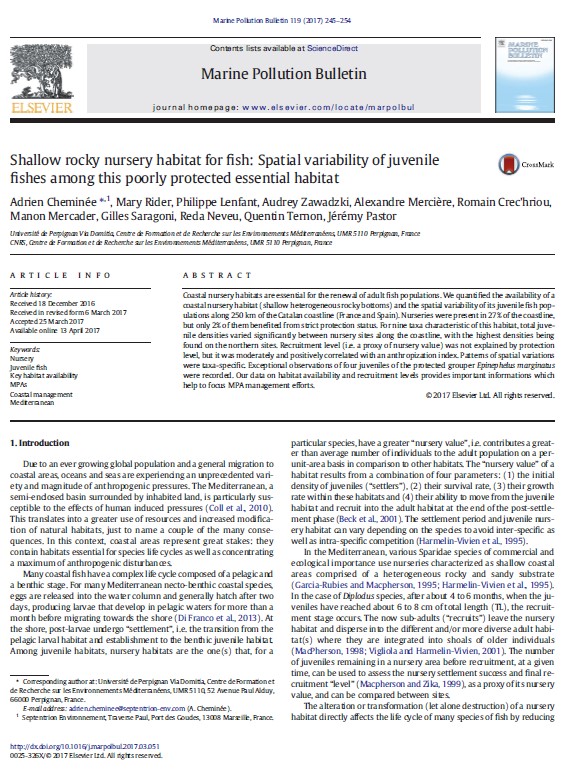
2017
Scientific publications and books
Shallow rocky nursery habitat for fish: spatial variability of juvenile fishes among this poorly protected essential habitat
Cheminée A., Rider M., Lenfant P., Zawadzki A., Mercière A., Crec’hriou R., Mercader M., Saragoni G., Neveu R., Ternon Q., Pastor J.
Coastal nursery habitats are essential for the renewal of adult fish populations.We quantified the availability of a coastal nursery habitat (shallow heterogeneous rocky bottoms) and the spatial variability of its juvenile fish populations along 250 km of the Catalan coastline (France and Spain). Nurseries were present in 27% of the coastline, but only 2% of them benefited from strict protection status. For nine taxa characteristic of this habitat, total juvenile densities varied significantly between nursery sites along the coastline, with the highest densities being found on the northern sites. Recruitment level (i.e. a proxy of nursery value) was not explained by protection level, but it was moderately and positively correlated with an anthropization index. Patterns of spatial variations were taxa-specific. Exceptional observations of four juveniles of the protected grouper Epinephelus marginatus were recorded. Our data on habitat availability and recruitment levels provides important informations which help to focus MPA management efforts.
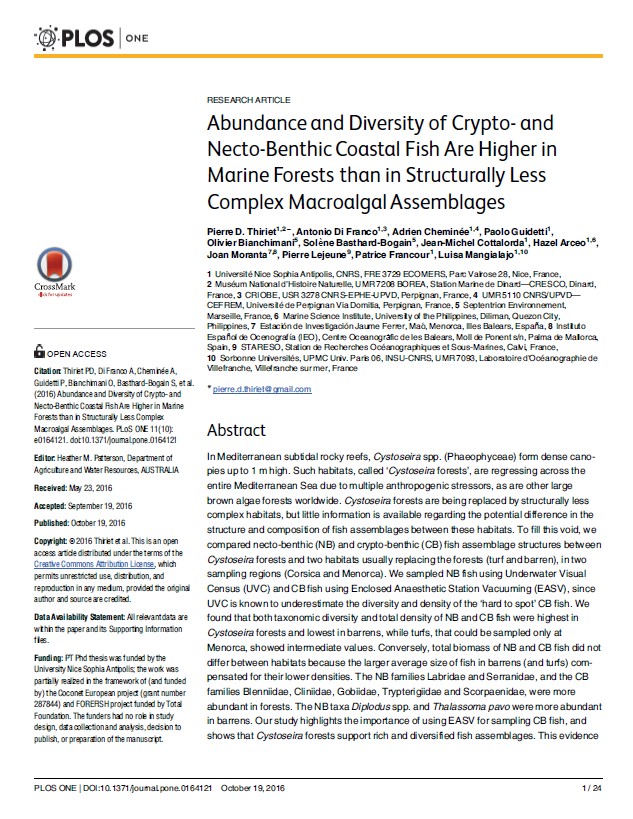
2016
Scientific publications and books
Abundance and diversity of crypto- and necto-benthic coastal fish are higher in marine forests than in structurally less complex macroalgal assemblages
Thiriet, P.D., Franco, A.D., Cheminée, A., Guidetti, P., Bianchimani, O., Basthard-Bogain, S., Cottalorda, J.-M., Arceo, H., Moranta, J., Lejeune, P., Francour, P., Mangialajo
In Mediterranean subtidal rocky reefs, Cystoseira spp. (Phaeophyceae) form dense canopies up to 1 m high. Such habitats, called `Cystoseira forests’, are regressing across the entire Mediterranean Sea due to multiple anthropogenic stressors. Cystoseira forests are being replaced by structurally less complex habitats, but little information is available regarding the potential difference in the structure and composition of fish assemblages between these habitats. To fill this void, we compared necto-benthic (NB) and crypto-benthic (CB) fish assemblage structures between Cystoseira forests and two habitats usually replacing the forests (turf and barren), in two sampling regions (Corsica and Menorca). We sampled NB fish using Underwater Visual Census (UVC) and CB fish using Enclosed Anaesthetic Station Vacuuming (EASV). We found that both taxonomic diversity and total density of NB and CB fish were highest in Cystoseira forests and lowest in barrens, while turfs, that could be sampled only at Menorca, showed intermediate values. Conversely, total biomass of NB and CB fish did not differ between habitats because the larger average size of fish in barrens (and turfs) compensated for their lower densities. The NB families Labridae and Serranidae, and the CB families Blenniidae, Cliniidae, Gobiidae, Trypterigiidae and Scorpaenidae, were more abundant in forests. The NB taxa Diplodus spp. and Thalassoma pavo were more abundant in barrens. Our study highlights the importance of using EASV for sampling CB fish, and shows that Cystoseira forests support rich and diversified fish assemblages. This evidence suggests that the ongoing loss of Cystoseira forests may impair coastal fish assemblages
and related goods and services to humans, and stresses the need to implement strategies for the successful conservation and/or recovery of marine forests.
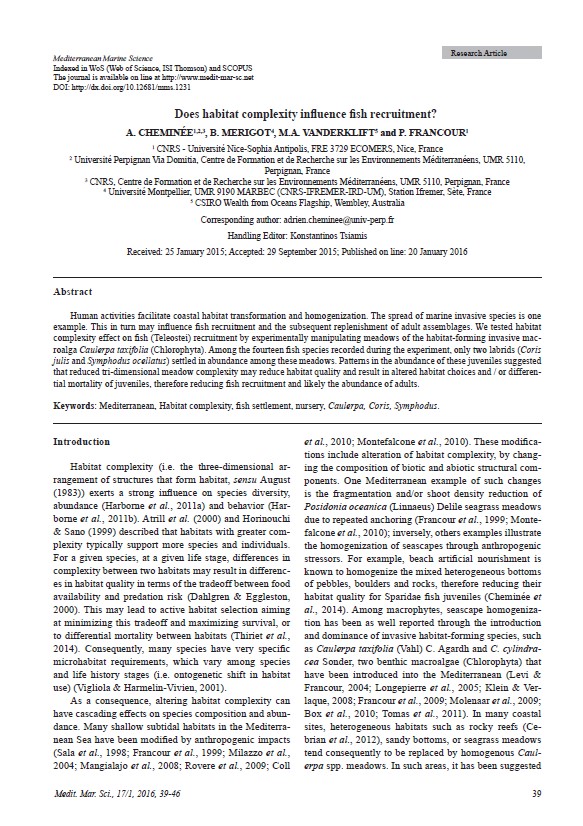
2016
Scientific publications and books
Does habitat complexity influence fish recruitment?
Cheminée A., Merigot B., Vanderklift M.A., Francour P.
Human activities facilitate coastal habitat transformation and homogenization. The spread of marine invasive species is one example. This in turn may influence fish recruitment and the subsequent replenishment of adult assemblages. We tested habitat complexity effect on fish (Teleostei) recruitment by experimentally manipulating meadows of the habitat-forming invasive macroalga Caulerpa taxifolia (Chlorophyta). Among the fourteen fish species recorded during the experiment, only two labrids (Coris julis and Symphodus ocellatus) settled in abundance among these meadows. Patterns in the abundance of these juveniles suggested that reduced tri-dimensional meadow complexity may reduce habitat quality and result in altered habitat choices and / or differential mortality of juveniles, therefore reducing fish recruitment and likely the abundance of adults.
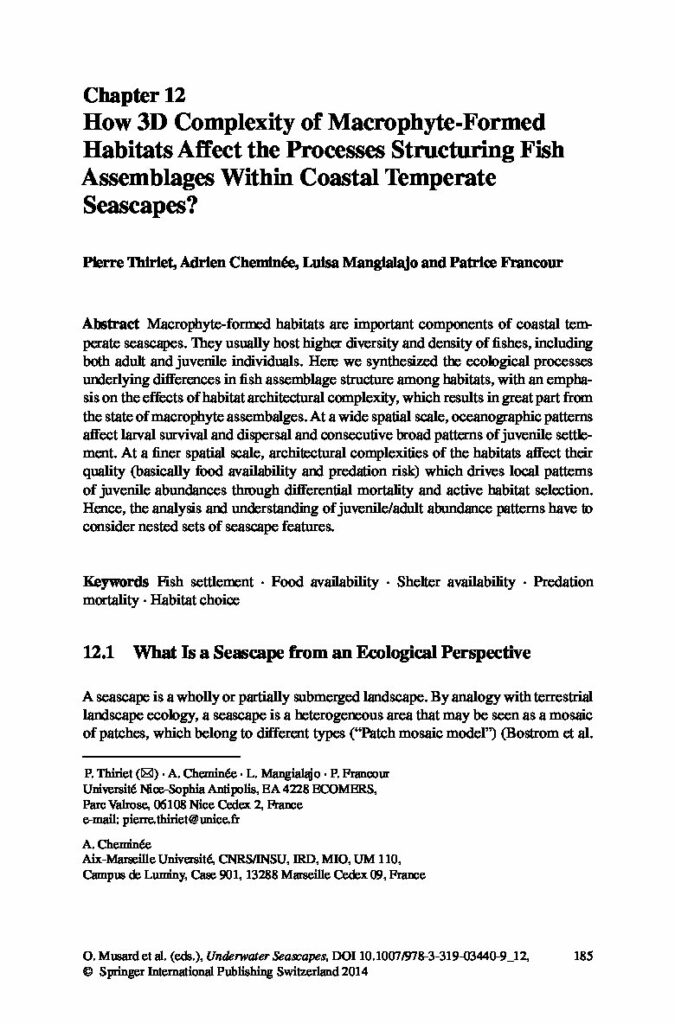
2014
Scientific publications and books
How 3D complexity of macrophyte-formed habitats affect the processes structuring fish assemblages within coastal temperate seascapes?
Thiriet P., Cheminée A., Mangialajo L., Francour P.
Macrophyte-formed habitats are important components of coastal temperate seascapes. They usually host higher diversity and density of fishes, including both adult and juvenile individuals. Here we synthesized the ecological processes underlying differences in fish assemblage structure among habitats, with an emphasis on the effects of habitat architectural complexity, which results in great part from the state of macrophyte assembalges. At a wide spatial scale, oceanographic patterns affect larval survival and dispersal and consecutive broad patterns of juvenile settlement. At a finer spatial scale, architectural complexities of the habitats affect their quality (basically food availability and predation risk) which drives local patterns of juvenile abundances through differential mortality and active habitat selection. Hence, the analysis and understanding of juvenile/adult abundance patterns have to consider nested sets of seascape features.
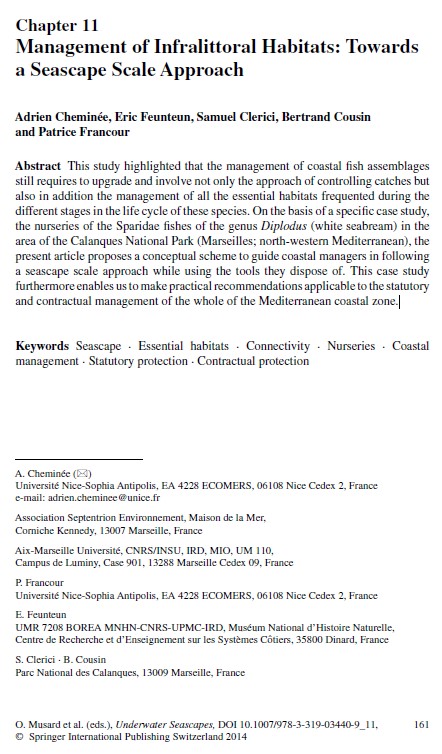
2014
Scientific publications and books
Management of infralittoral habitats: towards a seascape scale approach
Cheminée, A., Feunteun, E., Clerici, S., Cousin, B., Francour, P.
This study highlighted that the management of coastal fish assemblages still requires to upgrade and involve not only the approach of controlling catches but also in addition the management of all the essential habitats frequented during the different stages in the life cycle of these species. On the basis of a specific case study, the nurseries of the Sparidae fishes of the genus Diplodus (white seabream) in the area of the Calanques National Park (Marseilles; north-western Mediterranean), the present article proposes a conceptual scheme to guide coastal managers in following a seascape scale approach while using the tools they dispose of. This case study furthermore enables us to make practical recommendations applicable to the statutory and contractual management of the whole of the Mediterranean coastal zone.
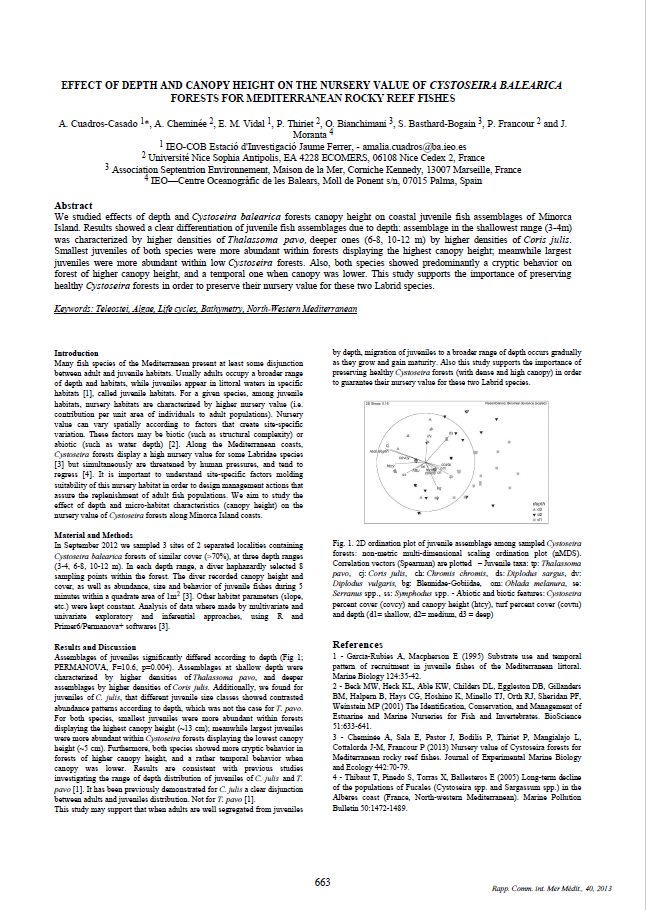
2013
Scientific publications and books
Effect of depth and canopy height on the nursery value of Cystoseira balearica forests for Mediterranean rocky reef fishes
Cuadros-Casado A., Cheminée A., Vidal E.M., Thiriet P., Bianchimani O., Basthard-Bogain S., Francour P., Moranta, J.
We studied effects of depth and Cystoseira balearica forests canopy height on coastal juvenile fish assemblages of Minorca Island. Results showed a clear differentiation of juvenile fish assemblages due to depth: assemblage in the shallowest range (3-4m) was characterized by higher densities of Thalassoma pavo, deeper ones (6-8, 10-12 m) by higher densities of Coris julis. Smallest juveniles of both species were more abundant within forests displaying the highest canopy height; meanwhile largest juveniles were more abundant within low Cystoseira forests. Also, both species showed predominantly a cryptic behavior on forest of higher canopy height, and a temporal one when canopy was lower.
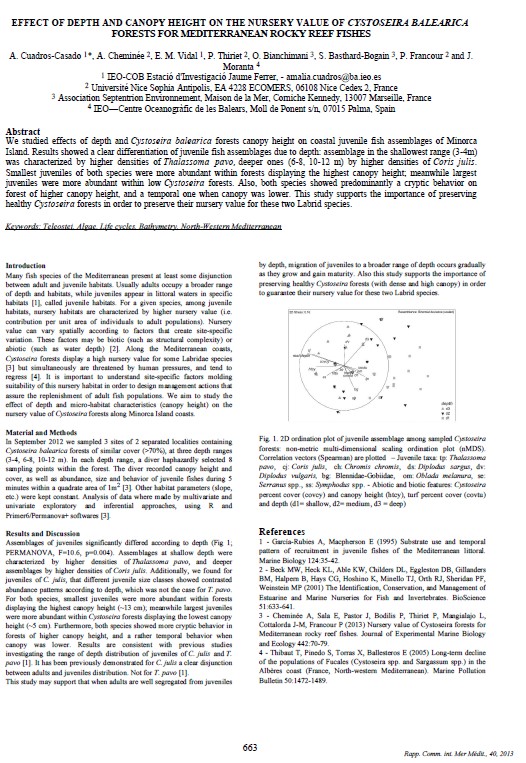
2013
Congresses and conferences
Effect of depth and canopy height on the nursery value of Cystoseira balearica forests for Mediterranean rocky reef fishes
Cuadros-Casado I. A., Cheminée A., Vidal-Cejuela E. M., Thiriet P., Bianchimani O., Basthard-Bogain S., Francour P., Moranta, J.
We studied effects of depth and Cystoseira balearica forests canopy height on coastal juvenile fish assemblages of Minorca Island. Results showed a clear differentiation of juvenile fish assemblages due to depth: assemblage in the shallowest range (3-4 m) was characterized by higher densities of Thalassoma pavo, deeper ones (6-8, 10-12 m) by higher densities of Coris julis. Smallest juveniles of both species were more abundant within forests displaying the highest canopy height; meanwhile largest juveniles were more abundant within low Cystoseira forests. Also, both species showed predominantly a cryptic behavior on forest of higher canopy height, and a temporal one when canopy was lower. This study supports the importance of preserving healthy Cystoseira forests in order to preserve their nursery value for these two Labrid species
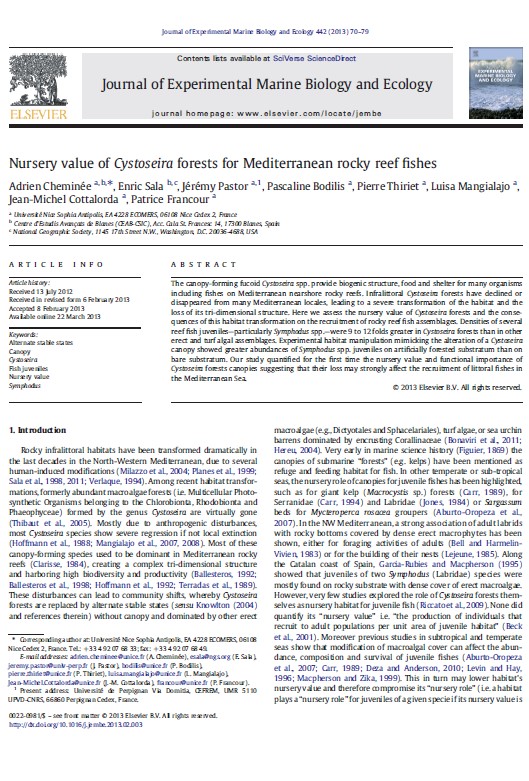
2013
Scientific publications and books
Nursery value of Cystoseira forests for Mediterranean rocky reef fishes
Cheminée A., Sala E., Pastor J., Bodilis P., Thiriet P., Mangialajo L., Cottalorda J.-M., Francour P.
The canopy-forming fucoid Cystoseira spp. provide biogenic structure, food and shelter for many organisms including fishes on Mediterranean nearshore rocky reefs. Infralittoral Cystoseira forests have declined or disappeared from many Mediterranean locales, leading to a severe transformation of the habitat and the loss of its tri-dimensional structure. Here we assess the nursery value of Cystoseira forests and the consequences of this habitat transformation on the recruitment of rocky reef fish assemblages. Densities of several reef fish juveniles—particularly Symphodus spp.—were 9 to 12 folds greater in Cystoseira forests than in other erect and turf algal assemblages. Experimental habitat manipulation mimicking the alteration of a Cystoseira canopy showed greater abundances of Symphodus spp. juveniles on artificially forested substratum than on bare substratum. Our study quantified for the first time the nursery value and functional importance of
Cystoseira forests canopies suggesting that their loss may strongly affect the recruitment of littoral fishes in the Mediterranean Sea.
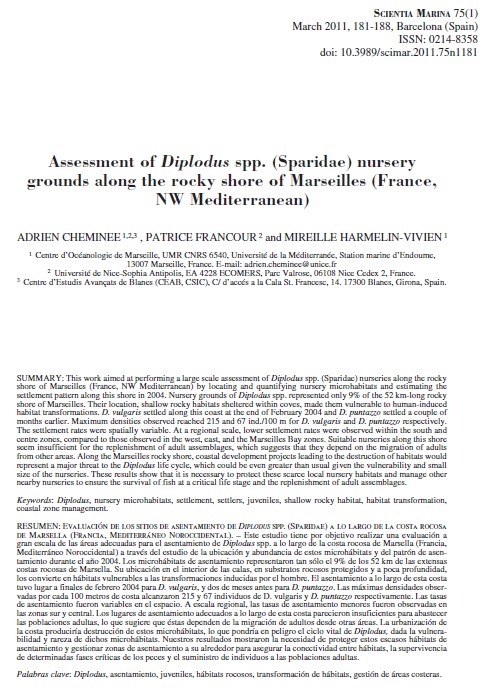
2011
Scientific publications and books
Assessment of Diplodus spp. (Sparidae) nursery grounds along the rocky shore of Marseilles (France, NW Mediterranean)
Cheminée A., Francour P., Harmelin-Vivien M.
This work aimed at performing a large scale assessment of Diplodus spp. (Sparidae) nurseries along the rocky shore of Marseilles (France, NW Mediterranean) by locating and quantifying nursery microhabitats and estimating the settlement pattern along this shore in 2004. Nursery grounds of Diplodus spp. represented only 9% of the 52 km-long rocky shore of Marseilles. Their location, shallow rocky habitats sheltered within coves, made them vulnerable to human-induced habitat transformations. D. vulgaris settled along this coast at the end of February 2004 and D. puntazzo settled a couple of months earlier. Maximum densities observed reached 215 and 67 ind./100 m for D. vulgaris and D. puntazzo respectively. The settlement rates were spatially variable. At a regional scale, lower settlement rates were observed within the south and centre zones, compared to those observed in the west, east, and the Marseilles Bay zones. Suitable nurseries along this shore seem insufficient for the replenishment of adult assemblages, which suggests that they depend on the migration of adults from other areas. Along the Marseilles rocky shore, coastal development projects leading to the destruction of habitats would represent a major threat to the Diplodus life cycle, which could be even greater than usual given the vulnerability and small size of the nurseries. These results show that it is necessary to protect these scarce local nursery habitats and manage other nearby nurseries to ensure the survival of fish at a critical life stage and the replenishment of adult assemblages.
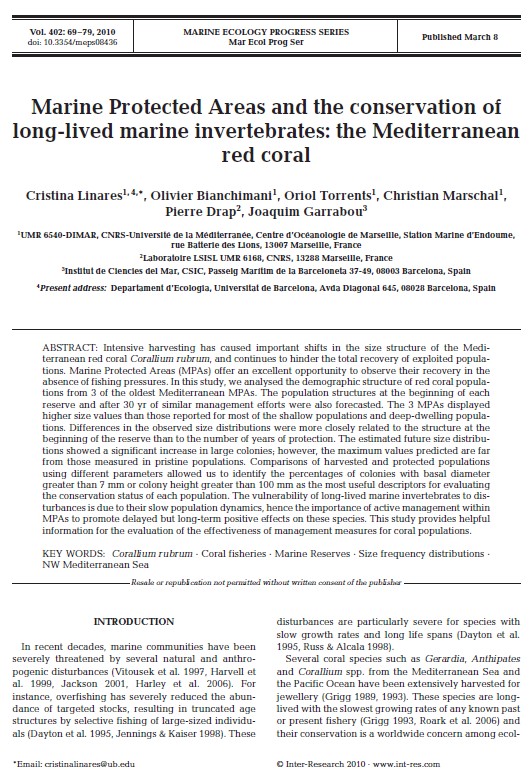
2010
Scientific publications and books
Marine Protected Areas and the conservation of long-lived marine invertebrates: the Mediterranean red coral
Linares C., Bianchimani O., Torrents O., Marschal C., Drap P., Garrabou J.
Intensive harvesting has caused important shifts in the size structure of the Mediterranean red coral Corallium rubrum, and continues to hinder the total recovery of exploited populations. Marine Protected Areas (MPAs) offer an excellent opportunity to observe their recovery in the absence of fishing pressures. In this study, we analysed the demographic structure of red coral populations
from 3 of the oldest Mediterranean MPAs. The population structures at the beginning of each reserve and after 30 yr of similar management efforts were also forecasted. The 3 MPAs displayed
higher size values than those reported for most of the shallow populations and deep-dwelling populations. Differences in the observed size distributions were more closely related to the structure at the beginning of the reserve than to the number of years of protection. The estimated future size distributions showed a significant increase in large colonies; however, the maximum values predicted are far from those measured in pristine populations. Comparisons of harvested and protected populations using different parameters allowed us to identify the percentages of colonies with basal diameter greater than 7 mm or colony height greater than 100 mm as the most useful descriptors for evaluating the conservation status of each population. The vulnerability of long-lived marine invertebrates to disturbances is due to their slow population dynamics, hence the importance of active management within MPAs to promote delayed but long-term positive effects on these species. This study provides helpful information for the evaluation of the effectiveness of management measures for coral populations.
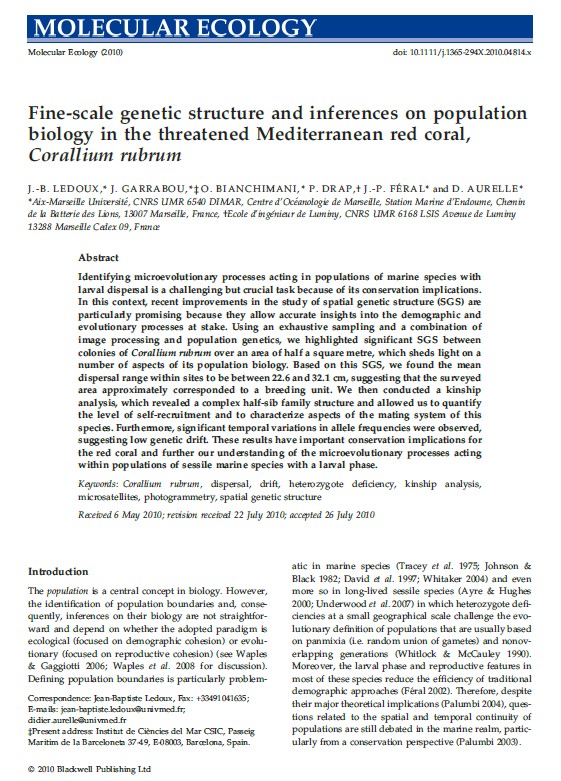
2010
Scientific publications and books
Fine-scale genetic structure and inferences on population biology in the threatened Mediterranean red coral, Corallium rubrum
Ledoux J.-B. , Garrabou J., Bianchimani O., Drap P., Féral J.-P., Aurelle D.
Identifying microevolutionary processes acting in populations of marine species with larval dispersal is a challenging but crucial task because of its conservation implications. In this context, recent improvements in the study of spatial genetic structure (SGS) are particularly promising because they allow accurate insights into the demographic and evolutionary processes at stake. Using an exhaustive sampling and a combination of image processing and population genetics, we highlighted significant SGS between colonies of Corallium rubrum over an area of half a square metre, which sheds light on a number of aspects of its population biology. Based on this SGS, we found the mean dispersal range within sites to be between 22.6 and 32.1 cm, suggesting that the surveyed area approximately corresponded to a breeding unit. We then conducted a kinship analysis, which revealed a complex half-sib family structure and allowed us to quantify the level of self-recruitment and to characterize aspects of the mating system of this species. Furthermore, significant temporal variations in allele frequencies were observed, suggesting low genetic drift. These results have important conservation implications for the red coral and further our understanding of the microevolutionary processes acting within populations of sessile marine species with a larval phase.
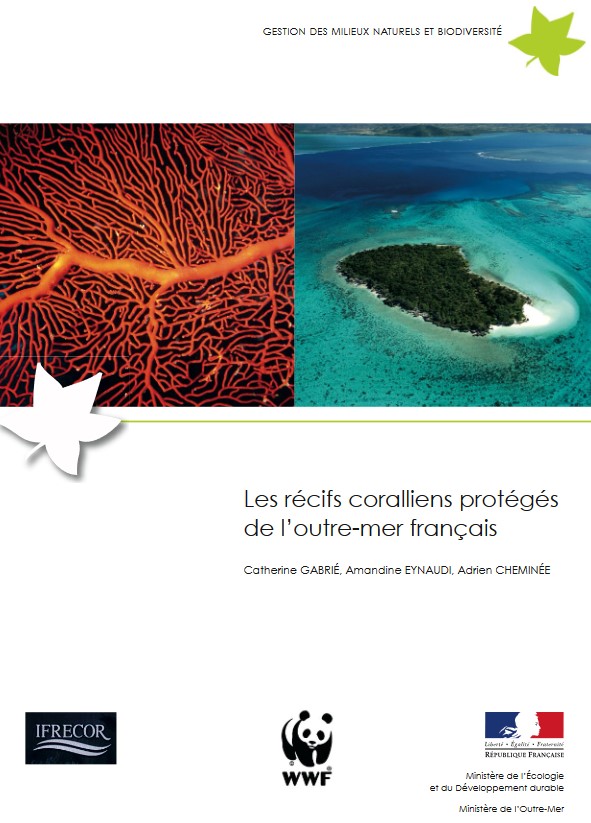
2007
Scientific publications and books
Protected coral reefs of French oversea territories
Gabrie C., Eynaudi A., Cheminée A.
This book was produced as part of the implementation of the national action plan of the French Initiative for Coral Reefs (IFRECOR). It is a contribution from WWF-France, a member of the IFRECOR national committee, to the implementation of federal action on marine protected areas.
